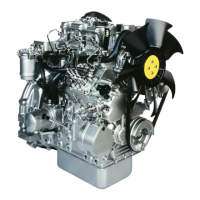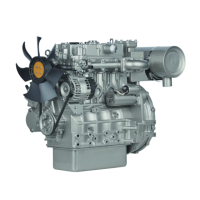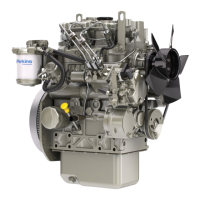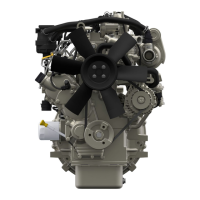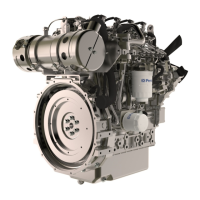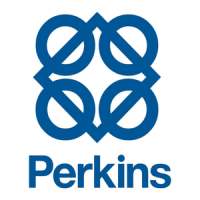
Do you have a question about the Perkins 403D-07 and is the answer not in the manual?
| Engine Model | 403D-07 |
|---|---|
| Engine Type | Diesel |
| Fuel System | Direct Injection |
| Aspiration | Naturally Aspirated |
| Cooling System | Liquid-cooled |
Warnings about chemicals in exhaust and engine components.
Information on manual usage and availability.
Overview of the safety section.
Overview of the operation section.
Overview of the maintenance section.
General warnings and safety symbols.
General hazards and precautions for safe operation.
Precautions to prevent burns from hot engine parts and fluids.
Guidelines to prevent fires and explosions related to fuel and electrical systems.
Safety measures to avoid crushing and cutting injuries.
Safety checks and preparations before engine start.
Safety precautions during engine startup.
Procedures for safely shutting down the engine.
Safety considerations related to the electrical system.
Illustrations of different engine models.
General description and variants of the 400 series engines.
Key technical specifications for different engine models.
Factors affecting engine service life and expected lifespan.
Warranty implications of using non-Perkins parts.
How to identify engine model, serial number, and other details.
Information for ordering parts and future reference.
Procedures for lifting and storing the engine.
Explanation of various engine gauges and their readings.
Overview of engine controls and features.
Procedures and precautions for starting the engine.
Proper techniques and practices for operating the engine efficiently.
Procedures for safely shutting down the engine.
Guidelines for operating the engine in cold weather conditions.
How fuel properties affect cold weather performance.
How fuel tanks and filters are affected by cold weather.
Fluid capacities for various engine systems.
Information on total cooling system capacity.
Recommendations for fuel and coolant specifications.
Specifications and requirements for diesel fuel quality.
Properties of diesel fuel like cetane number and viscosity.
Importance of fuel density for engine performance.
Regulations and requirements for fuel sulfur content.
Fuel lubricity and its role in preventing pump wear.
Information and recommendations for using biodiesel fuel.
Fuel requirements for operating in cold weather.
General information and precautions for engine coolant.
Role of glycol in coolant for freeze and boil protection.
Information about Extended Life Coolant (ELC) and its applications.
Procedures for maintaining ELC cooling systems.
Steps to convert from conventional antifreeze to Perkins ELC.
Managing contamination in ELC cooling systems.
Using heavy-duty antifreeze and Supplemental Coolant Additives (SCA).
General guidelines for engine oil selection, including API classifications.
Information on commercial engine oils and their classifications.
Relationship between TBN, fuel sulfur, and oil change intervals.
Acceptability and performance of synthetic base oils.
Acceptability and use of re-refined base stock oils.
Recommended lubricants for cold weather operation.
Using oil analysis for engine diagnostics and maintenance.
General recommendations for engine maintenance.
Safety procedures for welding on engines with electronic controls.
Schedule of maintenance tasks based on hours or time intervals.
Procedure for cleaning and testing the aftercooler core.
Inspection of the aftercooler for damage and debris.
Inspection of the alternator for proper operation and charging.
Inspecting and adjusting alternator and fan belts.
Procedure for replacing alternator and fan belts.
Steps for replacing the engine battery.
How to check and maintain the battery electrolyte level.
Procedures for safely disconnecting battery cables.
Procedure for changing commercial heavy-duty coolant.
Procedure for changing Extended Life Coolant (ELC).
How to check the coolant level in the recovery tank.
Testing and adding Supplemental Coolant Additive (SCA).
Procedure for replacing the water temperature regulator.
Maintenance recommendations for driven equipment.
Procedures for cleaning the engine.
Procedure for replacing the engine air cleaner element.
Maintenance of air cleaner elements.
Inspecting the air cleaner service indicator.
Checking and cleaning the engine air precleaner.
Procedure for replacing the engine crankcase breather.
Inspecting engine mounts for damage and proper torque.
How to check and maintain the engine oil level.
Procedures for changing engine oil and oil filter.
Procedure for replacing the oil filter.
How to fill the engine crankcase with the correct amount of oil.
Inspecting and adjusting engine valve lash for optimal performance.
Testing and changing fuel injectors.
Procedure for priming the fuel system to remove air.
Types of fuel filters that may be installed on the engine.
Ensuring air is removed from the primary fuel filter and system.
Procedure for priming the fuel system using a hand pump.
Procedure for priming the fuel system using an in-line pump.
Procedure for priming the fuel system using an electrical pump.
Procedure for priming the fuel system using a fuel transfer pump.
Procedures for replacing fuel system filters.
Procedure for replacing fuel filter elements.
Procedure for replacing fuel filters with a priming pump.
Procedure for replacing in-line fuel filters.
Procedure for replacing the primary fuel filter.
Procedure for draining the primary fuel filter and water separator.
Procedure for draining water and sediment from the fuel tank.
Recommendations for fuel storage tanks.
Inspecting and replacing hoses and clamps.
Procedure for cleaning the radiator.
Checking engine parameters for severe service applications.
Inspecting the starting motor for proper operation.
Inspecting the turbocharger for proper function and signs of wear.
Performing a visual inspection of the engine compartment.
Inspecting the water pump for leaks and proper operation.
General warranty information.
Information regarding emissions warranty coverage.




